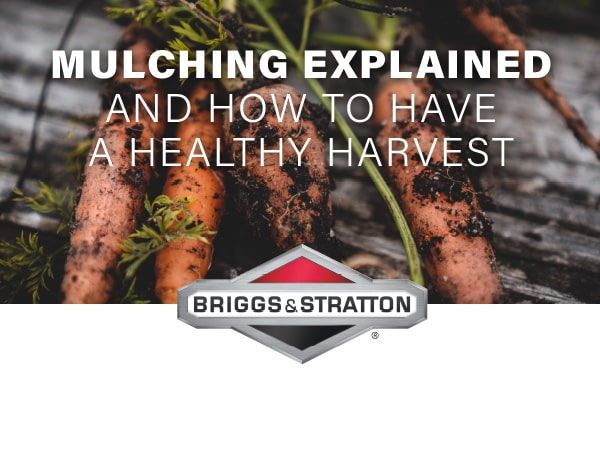Mulching explained and how to have a healthy harvest
In this month’s article, we have two most talked about topics for the end of the summer season – mulching and harvesting! Main growing season is coming to a close and now’s the time to prep and protect plants for next year. If you’ve been growing veg over the summer, now is also a popular time for harvesting your crops. Read on to find out how mulching can help your plants and how to have a healthy harvest.

What is mulching?
Mulch is layer of materials that you place on the top layer of your soil. It helps provide nutrients and lock in moisture to support soil and encourage healthy plant roots. It is a great idea to mulch all year round, but even more so in autumn when soil is warm and moist – as you want to lock this in over the winter! Mulching provides a barrier keep soil strong, weeds away and plants protected from frost or drastic temperature changes.
There is a wide variety of mulches available. They usually fall into two categories:
Biodegradable mulches
We’d always recommend a natural and sustainable option. Biodegradable mulches can be made up of materials like fallen leaves, leaf mould, garden compost and woodchips or bark. This type of mulch breaks down gradually to release nutrients into the soil. These are generally better for your plants as the extra nutrients gives them a boost, but you will have lay this type of mulch more often.
Non-biodegradable mulches
These are more permanent layers like pebbles, gravel, slate, or stone chippings. These won’t boost the fertility of the soil but will help prevent weeds and trap some moisture in. They can also act as a decorative feature, so a great option if you’re looking to add more texture or colour to your garden.
When and how to mulch?
It’s best to mulch in mid-spring, when weeds have not yet germinated, and autumn, as plants are dying back. New plants can be mulched at any time of year when you want to keep moisture in the soil and weeds away, to give them the best chance of establishing.
Mulching is a very easy process with a big payoff! Simply remove existing weeds and lay your mulch over moist soil. For biodegradable mulch, you’ll need a layer of at least 5-7.5cm thick to be effective. Don’t smother plants or pile mulch against the stems as this can cause stems to soften. Leave a small circle around the base of plants, and for trees and shrubs, only mulch to the radius of the canopy.
And that’s it! Happy mulching!

How to have a healthy harvest
While you’re here we’ve pulled together the best quick tips to encourage you to have the healthiest harvest you can…
1. Use the right tools.
Be careful when picking your fruits and vegetables as you could tear or rip the produce. This could cause bigger issues down the road as a wrong cut can damage the plant overall and prevent future growth. Try using scissors or a sharp knife to get a clean and precise pick. Try not to tread over vines as tears can also act as an entry point for diseases.
2. Use a basket.
Carry your produce in a purpose-built harvesting basket. These are often made to prevent damages to your product and include handy features such as a big strap to sling over your shoulder. Some even come with small holes so you can rinse your fruit and veg straight away.
3. Harvest often.
Plants want to reproduce but if you’re not picking, it may think its job is done. So the more you harvest, the more you’ll get from your plants. Keep an eye on beans, which can go from tender to tough in no time at all, and courgettes which can grow bigger than you’d think in just a couple of days!
4. Keep your seed packs.
These will have the best information on your plant type and when it has reached maturity. It can take a little time to know how big your produce should be, so check the timings on your packs can help you know when your vegetables are at their prime size, flavour and nutrition.
5. Harvest outer leaves first.
Leafy vegetables like lettuces sprout from the centre of the plant, so unless you are harvesting the entire plant, pick the larger outer leaves first and leave the centre to continue developing.
It's a busy time of year for gardeners, and we hope we've inspired you to get out in your garden this autumn! Mulching and harvesting are just a few tasks to complete before winter. Not ready to give up on summer? Check out our summer tips here or follow us on Facebook.






